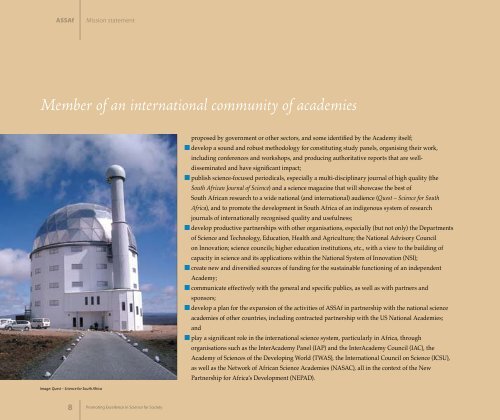Academy of Science South Africa 2005/6 Annual Report
Academy of Science South Africa 2005/6 Annual Report
Academy of Science South Africa 2005/6 Annual Report
- No tags were found...
You also want an ePaper? Increase the reach of your titles
YUMPU automatically turns print PDFs into web optimized ePapers that Google loves.
ASSAfMission statementMember <strong>of</strong> an international community <strong>of</strong> academiesImage: Quest – <strong>Science</strong> for <strong>South</strong> <strong>Africa</strong>proposed by government or other sectors, and some identified by the <strong>Academy</strong> itself;develop a sound and robust methodology for constituting study panels, organising their work,including conferences and workshops, and producing authoritative reports that are welldisseminatedand have significant impact;publish science-focused periodicals, especially a multi-disciplinary journal <strong>of</strong> high quality (the<strong>South</strong> <strong>Africa</strong>n Journal <strong>of</strong> <strong>Science</strong>) and a science magazine that will showcase the best <strong>of</strong><strong>South</strong> <strong>Africa</strong>n research to a wide national (and international) audience (Quest – <strong>Science</strong> for <strong>South</strong><strong>Africa</strong>), and to promote the development in <strong>South</strong> <strong>Africa</strong> <strong>of</strong> an indigenous system <strong>of</strong> researchjournals <strong>of</strong> internationally recognised quality and usefulness;develop productive partnerships with other organisations, especially (but not only) the Departments<strong>of</strong> <strong>Science</strong> and Technology, Education, Health and Agriculture; the National Advisory Councilon Innovation; science councils; higher education institutions, etc., with a view to the building <strong>of</strong>capacity in science and its applications within the National System <strong>of</strong> Innovation (NSI);create new and diversified sources <strong>of</strong> funding for the sustainable functioning <strong>of</strong> an independent<strong>Academy</strong>;communicate effectively with the general and specific publics, as well as with partners andsponsors;develop a plan for the expansion <strong>of</strong> the activities <strong>of</strong> ASSAf in partnership with the national scienceacademies <strong>of</strong> other countries, including contracted partnership with the US National Academies;andplay a significant role in the international science system, particularly in <strong>Africa</strong>, throughorganisations such as the Inter<strong>Academy</strong> Panel (IAP) and the Inter<strong>Academy</strong> Council (IAC), the<strong>Academy</strong> <strong>of</strong> <strong>Science</strong>s <strong>of</strong> the Developing World (TWAS), the International Council on <strong>Science</strong> (ICSU),as well as the Network <strong>of</strong> <strong>Africa</strong>n <strong>Science</strong> Academies (NASAC), all in the context <strong>of</strong> the NewPartnership for <strong>Africa</strong>’s Development (NEPAD).Promoting Excellence in <strong>Science</strong> for Society









![National Research Foundation Annual Report 2008 / 2009 [Part 2]](https://img.yumpu.com/49774036/1/177x260/national-research-foundation-annual-report-2008-2009-part-2.jpg?quality=85)






